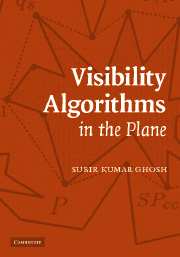5 - Visibility Graphs
Published online by Cambridge University Press: 14 August 2009
Summary
Problems and Results
The visibility graph is a fundamental structure in computational geometry; some early applications of visibility graphs include computing Euclidean shortest paths in the presence of obstacles [249] and in decomposing two-dimensional shapes into clusters [306]. The visibility graph (also called the vertex visibility graph) of a polygon P with or without holes is the undirected graph of the visibility relation on the vertices of P. The visibility graph of P has a node for every vertex of P and an edge for every pair of visible vertices in P. Figure 5.1(b) shows the visibility graph of the polygon in Figure 5.1(a). We sometimes draw the visibility graph directly on the polygon, as shown in Figure 5.1(c). It can be seen that every triangulation of P corresponds to a sub-graph of the visibility graph of P. The visibility graph of a line segment arrangement is defined similarly, where the endpoints of the line segments are represented as the nodes of the visibility graph.
Consider the problem of computing the visibility graph of a polygon P (with or without holes) having a total of n vertices. The visible pairs of vertices in P can be computed by checking intersections of segments connecting pairs of vertices in P with each polygonal edge of P. This naive method takes O(n3) time as in the first algorithm for computing the visibility graph given by Lozano-Perez and Wesley [249].
Information
- Type
- Chapter
- Information
- Visibility Algorithms in the Plane , pp. 136 - 170Publisher: Cambridge University PressPrint publication year: 2007
